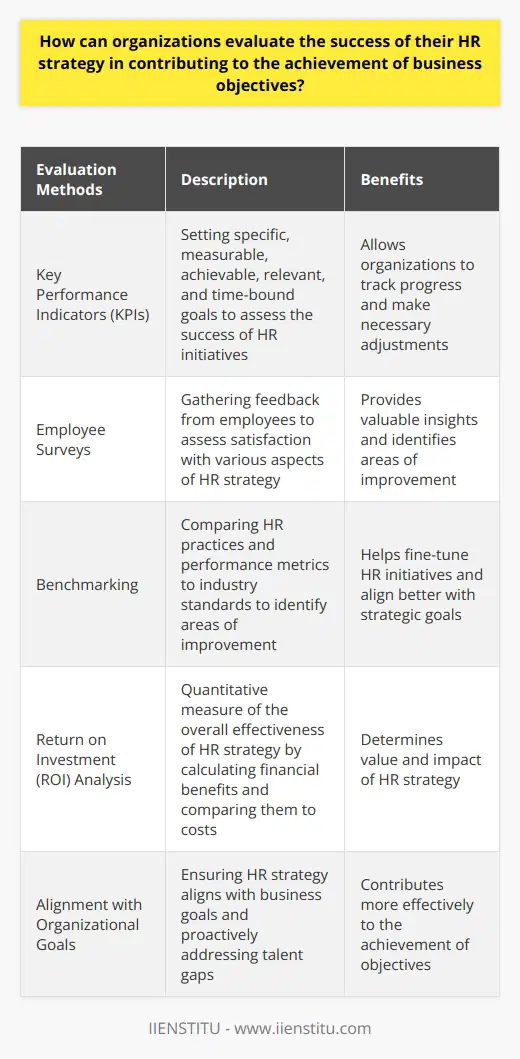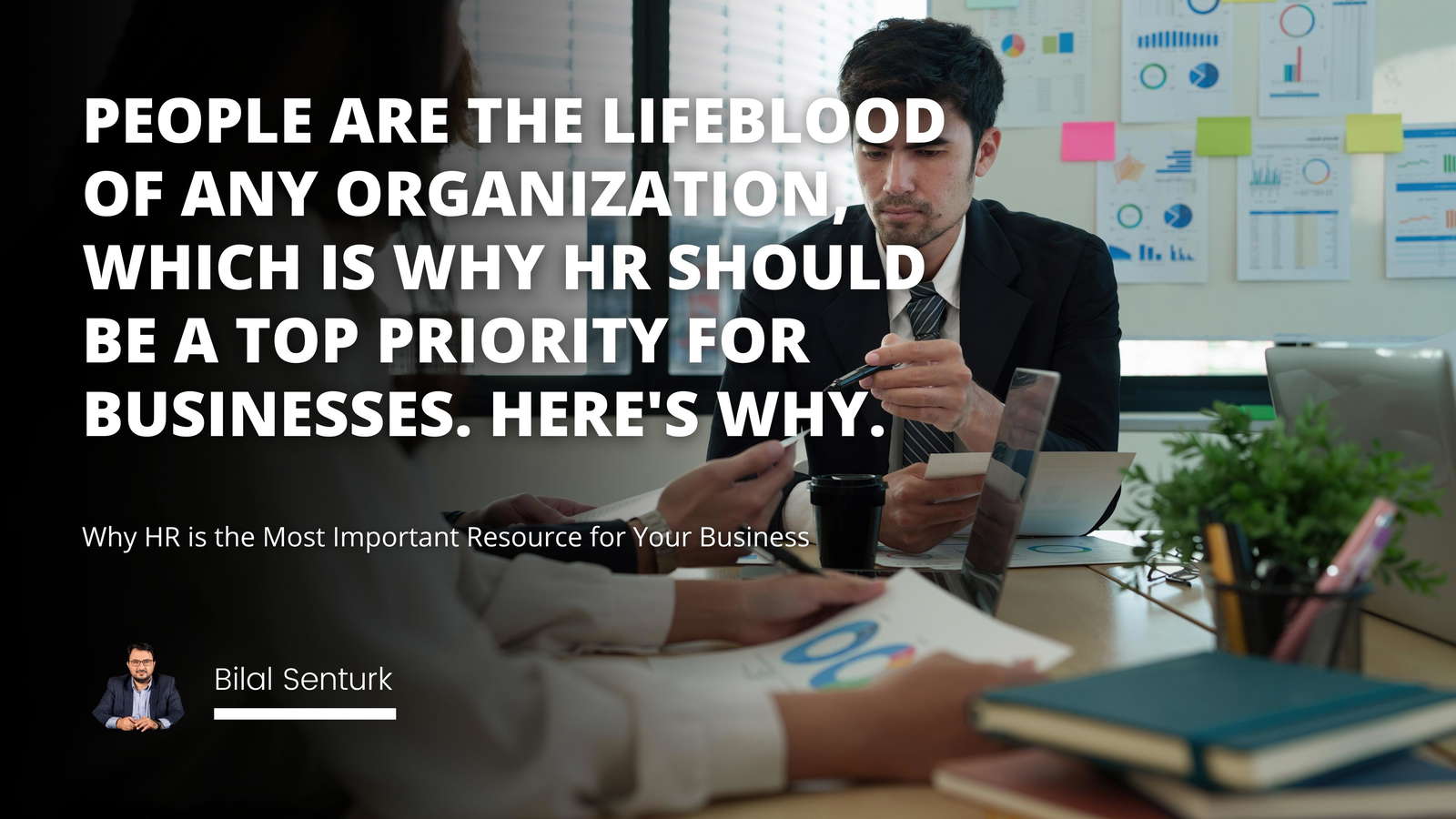
The Need for Alignment in Corporate HR
Benefits of Alignment
How to Implement Alignment
Organizations that strive for success and look to the future must implement corporate human resource (HR) strategies that align with divisional and unit HR strategies. There is an inherent need to have HR strategies aligned across the board and work together to deliver sustainable performance. Failure to do so can result in inefficiency, lack of clear strategic direction, lack of accountability, and poor performance.
The Need for Alignment in Corporate HR
In an ever-changing and increasingly competitive business environment, an organization needs to be agile and responsive to changes in the market. The only way to ensure this is to ensure that the organization has a unified vision of reaching its goals. This vision must also consider the evolving needs and demands of the changing business landscape. To achieve this, corporate HR must have a clear and aligned idea of where the organization needs to be and what must be done to get there.
Looking at Div/Unit HR
Divisional and unit HR strategies are all aimed at the same overarching goal – to empower people to achieve their full potential. Therefore, these strategies must be carefully integrated, allowing divisions and units to work together while remaining separate. Otherwise, the organization's overall strategy may become fragmented, leading to misalignment, redundancy, and inefficiency.
Benefits of Alignment
When done correctly, aligning divisional and unit strategies in corporate HR can benefit an organization. Here, we look at a few of these.
More Effective Planning
HR Service Delivery: Optimizing Workforce Value in Modern Businesses
HR Risk Management: Strategies for Optimal Employee Performance
When divisional and unit HR strategies are aligned, organizational performance and results can be more carefully planned and controlled through a unified set of KPIs and expected performance targets. Organizations can then use the aligned strategies to create a roadmap toward long-term success and better utilize their resources.
Improved Performance and Results
Aligning HR strategies across the board can also lead to improved organizational performance and results. By having a unified and clear design, divisions and units can work together more effectively and make better decisions to help the organization reach its goals.
Increased Efficiency
Aligning strategies across the organization can also lead to increased efficiency. This is mainly due to eliminating redundant processes and creating a more streamlined approach to achieving goals. This can lead to cost savings and improved performance, enabling the organization to compete more effectively in the market.
How to Implement Alignment
Implementing an alignment of corporate HR strategies requires careful planning and thought. A few key steps need to be taken to ensure the strategy is cohesive and effective.
Establish Goals
The first step is to establish clear, measurable goals for each of the divisions and units in the organization. These should be detailed and clearly define what is expected from each division or department.
Create a Plan
Once the goals have been established, the next step is to create a detailed plan for achieving those goals. Again, the program should be tailored to each division or unit, involving milestones and stakeholders.
Monitor and Revise
Finally, the plan should be monitored and regularly revised depending on the organization's needs. It should also be modified to consider changes in the external environment.
In conclusion, having a clear and effective corporate HR strategy is paramount for any organization that wants to be successful and reach its goals. To achieve corporate objectives, the divisional and unit strategy must be carefully aligned and integrated. This can lead to improved performance, increased efficiency, and better results. However, aligning strategies requires careful planning and thought and should involve establishing clear goals, creating a tailored plan, and monitoring and revising as needed.
Aligning corporate and divisional/unit HR strategies can lead to improved performance, increased efficiency, and better results.
Establishing goals, creating a detailed plan, monitoring, and revising should all be part of the process.
Implementing an alignment of corporate HR strategies requires careful planning and thought.
Organizational success is achieved by unifying HR strategies and empowering individual divisions to execute them effectively.
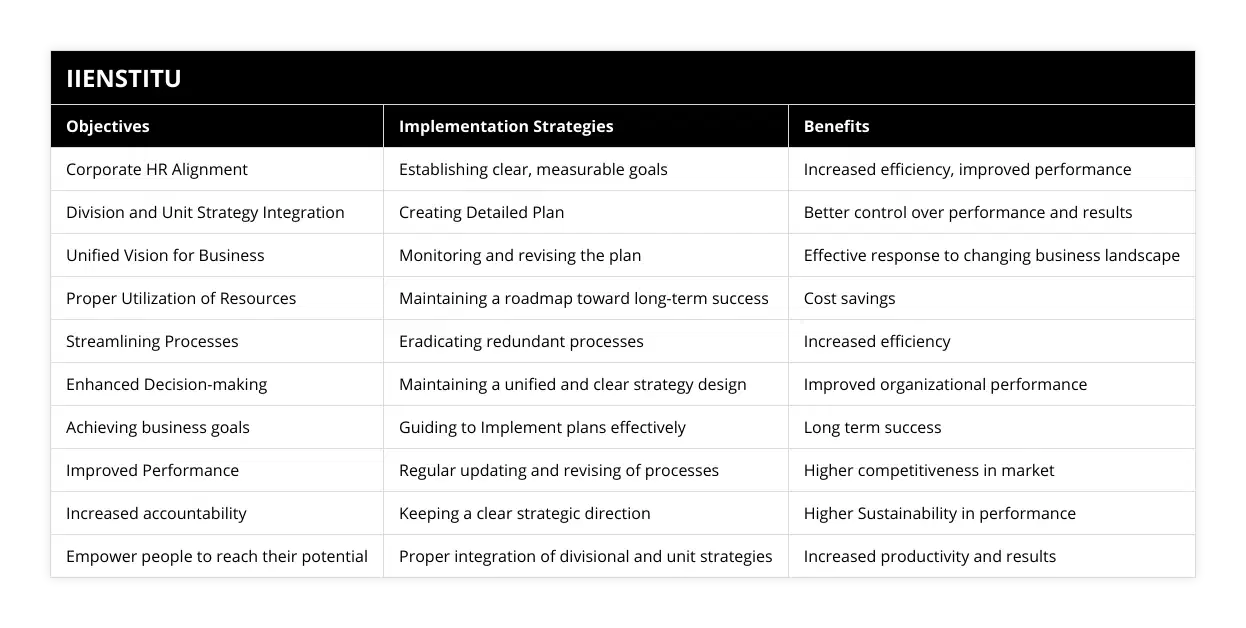
Frequently Asked Questions
What strategies are employed by Corporate HR to ensure the successful alignment of Div/Unit HR to their plans?
Corporate HR is essential in organizations, providing critical services such as training and development, employee compensation, labor relations, and talent acquisition. However, the success of Corporate HR depends on the efficient alignment of its processes and initiatives to the objectives of the organization’s Divisions and Units. Ensuring successful alignment requires the deployment of well-organized strategies.
One key strategy employed by Corporate HR is to ensure that Division/Unit HR activities are integrated with the larger organizational structure and goals. Therefore, corporate HR must understand the structure and culture of their organization to ensure proper alignment. This includes considering organizational goals, core competencies, and mission statements. Through this knowledge, Corporate HR can create a comprehensive alignment plan that ensures each Division and Unit aligns the processes and initiatives to the organizational objectives.
A second key strategy employed by Corporate HR is to create effective communication channels between Div/Unit HR and Corporate HR. Corporate HR needs to stay informed of the progress and changes of Div/Unit HR to maintain accurate alignment. To facilitate this process, Corporate HR must strive to create frequent communication channels, such as in-person meetings and online portals. This allows Corporate HR to stay up-to-date on Div/Unit HR objectives and provide feedback and guidance on the best strategy for alignment.
In addition, Corporate HR should create a platform for Div/Unit HR to voice their objectives and ideas. By providing Div/Unit HR an avenue to give input, Corporate HR can ensure that Div/Unit HR goals are well-represented in the organization. Additionally, this creates an opportunity for Corporate HR to provide feedback and guidance to ensure that Div/Unit HR is developing initiatives that align with the organization’s objectives.
Finally, Corporate HR should consider creating a rewards program to motivate Div/Unit HR personnel to achieve alignment. This type of program allows employees to become invested in achieving their goals and objectives and those of the organization. A successful rewards program encourages employees to develop strategies and initiatives aligned with the organization’s objectives.
In conclusion, Corporate HR can and should take on a proactive role in ensuring the successful alignment of Div/Unit HR to their plans. By implementing integration, communication, input, and rewards strategies, Corporate HR can foster successful relationships between Div/Unit HR and Corporate HR initiatives. As a result, organizations can benefit from efficiencies, cost savings, and improved workflow when uniform alignment is achieved.
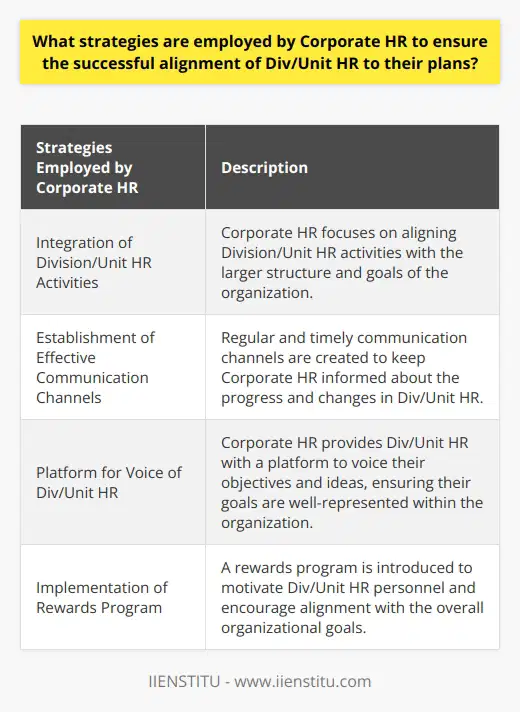
How can Corporate HR ensure that Div/Unit HR is implementing plans effectively?
Corporate HR departments are often responsible for creating, and monitoring plans specific to each area of an organization. Ensuring that Div/Unit HR personnel are effectively implementing these plans is one of the critical responsibilities of Corporate HR. This article reviews some best practices for Corporate HR to ensure that Div/Unit HR is implementing programs effectively.
First and foremost, Corporate HR should ensure that clear and detailed instructions are provided with each plan. Where possible, it can be effective to have Div/Unit HR personnel sign off on any projects to ensure that they have read and understood the plans. This also helps to record any changes that have to be made along the way.
Second, Corporate HR should maintain regular contact with Div/Unit HR personnel. Regular check-ins and communication can provide clear direction and help Div/Unit HR personnel identify variables needing extra attention. Regular meetings can also provide a platform to discuss challenges, successes, or experiences.
Third, it is beneficial for Corporate HR to provide training and guidance to Div/Unit HR personnel. By doing this, Corporate HR can help Div/Unit HR personnel build knowledge and skills to independently solve any problems encountered in implementing plans. Building knowledge and empowering Div/Unit HR personnel to make decisions can lead to more efficient and practical implementations.
Finally, Corporate HR should provide precise monitoring and feedback mechanisms. By regularly monitoring progress, Corporate HR can ensure that plans are implemented correctly and on schedule. In addition, feedback should be offered constructively to provide ongoing support and guidance to Div/Unit HR personnel.
In conclusion, Corporate HR is essential in ensuring Div/Unit HR personnel implement plans effectively. The best way is to provide clear and detailed instructions, maintain regular contact, provide training and guidance, and develop precise monitoring and feedback mechanisms. By following these best practices, Corporate HR can ensure Div/Unit HR personnel implement plans to their full potential.
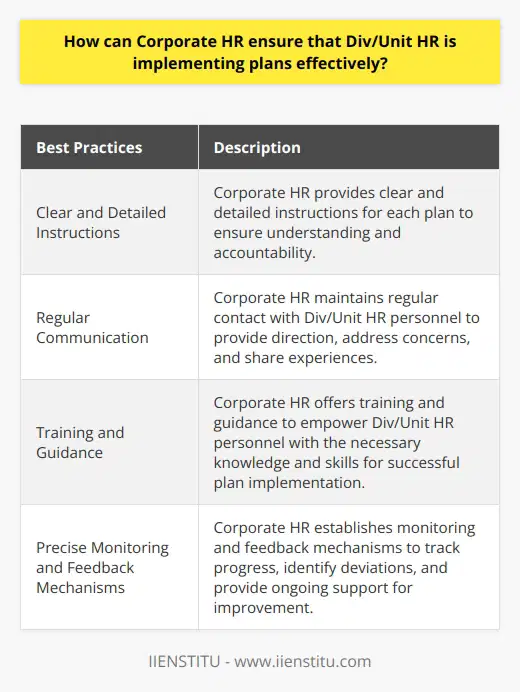
What role does Corporate HR have in developing and maintaining strong relationships between Div/Unit HR leaders?
The role of Corporate Human Resources (HR) is integral in developing and maintaining solid relationships between Div/Unit HR leaders in any organization. Organizations must depend on active collaboration between their human resource departments to achieve success and reach their goals. The human resource departments at each division or unit must be aligned with the corporate level to ensure they are all on the same page. This alignment is essential to ensure the organization's objectives are met and the smooth department transition. Corporate HR has the central role of maintaining strong relationships between the divisions and units and can ensure that their employees are working together effectively.
To begin with, Corporate HR is responsible for ensuring that the communication channels between the Div/Unit HR leaders are maintained and open to ensure they can exchange information and learn from each other promptly. They should ensure they are actively involved in the process and available to answer questions or provide guidance. Additionally, Corporate HR should provide the necessary tools and resources to support the HR leaders in their daily tasks and operations. This can include access to training and development opportunities, performance management systems, job descriptions, and HR policies and procedures.
Furthermore, Corporate HR should also identify shared goals and objectives (if applicable) between the Div/Unit HR leaders to ensure a common understanding of their roles and responsibilities. This shared understanding of objectives and goals will ensure that the Div/Unit HR leaders can work together proactively and not be isolated.
Finally, Corporate HR can proactively develop strong relationships between Div/Unit HR leaders by establishing a well-defined relationship management process. This process should involve defining expectations, establishing timelines, setting goals, and regularly communicating progress. This ensures that the Div/Unit HR leaders are aware of their objectives' progress and can be held accountable for their deliverables.
Overall, the role of Corporate HR in developing and maintaining solid relationships between Div/Unit HR leaders is critical to organizational success. Corporate HR can ensure that its Div/Unit HR leaders work together effectively and meet their goals by providing the necessary resources, proactively engaging in relationship management, and identifying shared objectives.
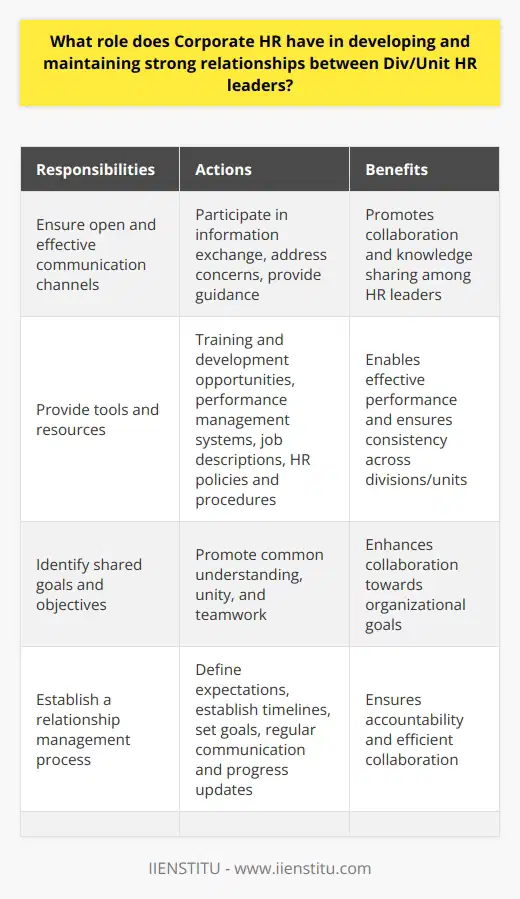
How do you ensure effective communication between HR and other business departments to achieve alignment with business strategy?
Effective Communication between HR and Business Departments
Proper Planning and Establishment of Goals
To ensure effective communication between the human resources (HR) department and other business departments, it is crucial to establish clear goals, objectives, and strategies. By identifying key performance indicators (KPIs) and aligning them with the overall business strategy, HR can provide the necessary support and guidance to other departments for achieving their targets.
Regular Interdepartmental Meetings
To facilitate open lines of communication, HR should conduct regular meetings with other business departments to discuss progress, share information, and address any concerns. These sessions can be held in person or through online platforms, and they are an essential element in ensuring that HR and other departments remain on the same page concerning the company’s strategic direction.
Use of Collaborative Tools
Incorporating collaborative tools such as project management software and shared communication platforms can help streamline communication between HR and other departments. These digital resources enable teams to easily share updates, track progress, and work more efficiently, ultimately leading to better alignment with the company’s strategic goals.
Continuous Feedback Loop
By implementing a continuous feedback loop, HR can maintain a strong connection with other departments while working toward alignment with the company’s strategy. This includes collecting ongoing input from employees, providing constructive feedback and coaching, and addressing any challenges or obstacles that may arise along the way.
Active Listening
Effective communication between HR and other business departments require active listening on both sides. This means truly hearing, understanding, and acknowledging the concerns or input of others, and making a conscious effort to respond and address those issues. By actively listening, HR and other departments can maintain strong working relationships and collaborate more effectively in pursuit of company goals.
In conclusion, achieving alignment with business strategy through effective communication between HR and other departments requires proactive planning, regular opportunities to connect, and a commitment to continuously improve. By leveraging these strategies, HR professionals can help support the growth and success of the company as a whole.
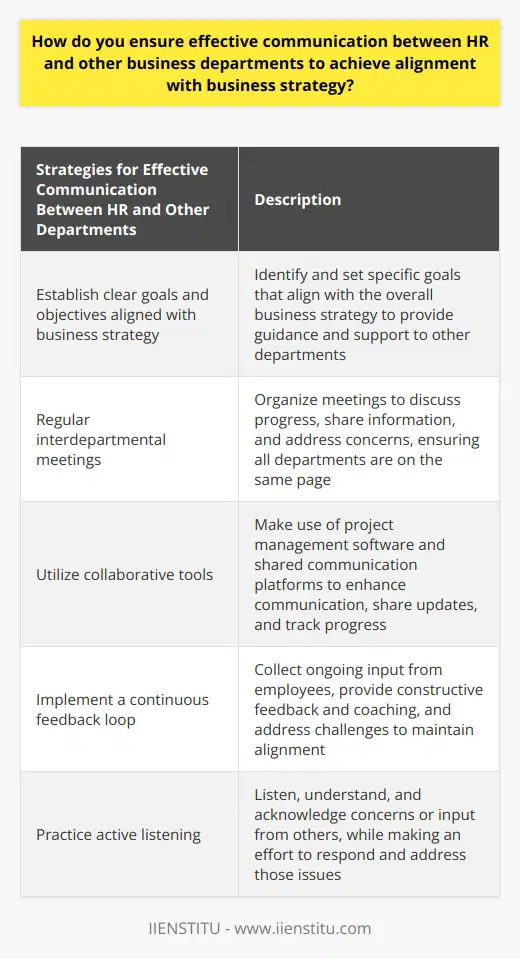
What are the key components of a well-developed HR strategy that supports the overall business goals?
Understanding HR Strategy Objectives
A well-developed human resources (HR) strategy consists of several key components that support the overall business goals. First and foremost, it is essential for an HR strategy to align with organizational objectives. This alignment ensures that HR initiatives actively contribute to achieving the company's vision, mission, and long-term success.
Recruitment and Selection Criteria
The recruitment and selection process is another crucial element of an effective HR strategy. It involves identifying the required skills, knowledge, and attributes for different roles, as well as creating a fair and transparent selection process. By doing so, the organization can attract, select, and retain the most qualified individuals who contribute positively to the team and the organization's goals.
Training and Development Programs
To develop employees and enhance their performance, an HR strategy must also incorporate regular training and development programs. These programs should be tailored to address specific needs in the workforce, with a focus on improving individual competencies and overall organizational efficiency. This continuous learning approach fosters a culture of growth and adaptability, ultimately promoting long-term success.
Performance Management Systems
Another essential component of a robust HR strategy is an efficient performance management system. This system includes setting individual goals, conducting regular performance appraisals, and providing timely feedback to employees. By doing so, the organization can uncover areas for improvement, recognize staff achievements, and ensure employees consistently contribute to the overall business objectives.
Employee Engagement and Retention
A well-developed HR strategy should also focus on fostering employee engagement and retention. High employee engagement levels contribute to increased productivity, improved customer satisfaction, and higher profits. HR practitioners can accomplish this by implementing various initiatives, such as offering competitive compensation and benefits packages, providing opportunities for career growth, and maintaining a healthy work-life balance.
In conclusion, a comprehensive HR strategy that considers a range of key components, such as alignment with business objectives, recruitment and selection criteria, training and development programs, performance management systems, and employee engagement, can effectively support the overall business goals. By doing so, organizations can optimize their human capital, drive growth, and ultimately achieve long-term success.
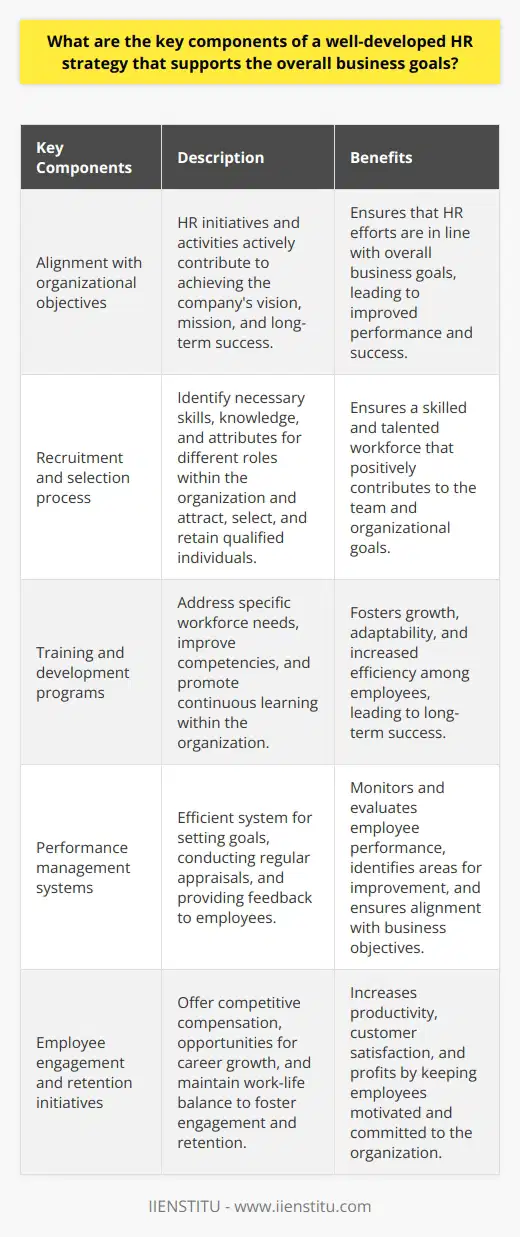
How can organizations evaluate the success of their HR strategy in contributing to the achievement of business objectives?
Evaluation of HR Strategy Success
Organizations can evaluate the success of their HR strategy in contributing to the achievement of business objectives through several methods. These methods aim to measure the effectiveness of HR initiatives and the alignment of human resources with organizational goals.
Key Performance Indicators (KPIs)
By setting specific, measurable, achievable, relevant, and time-bound Key Performance Indicators (KPIs) for HR initiatives, organizations can assess the success of their HR strategy. KPIs should align with the overall business objectives and can include metrics such as employee turnover, employee engagement, and productivity.
Employee Surveys
Organizations can gather feedback from employees through regular surveys to assess their satisfaction with various aspects of HR strategy, such as recruitment processes, employee development programs, and workplace culture. Analyzing survey results can provide valuable insights into the efficacy of the HR strategy in meeting organizational goals.
Benchmarking against Industry Standards
Comparing HR practices and performance metrics to industry benchmarks can help organizations to identify areas of improvement and gauge the success of their HR strategy in contributing to business objectives. By understanding the industry's best practices, organizations can fine-tune their HR initiatives to align better with overall strategic goals.
Return on Investment (ROI) Analysis
Measuring the return on investment of HR programs can provide a quantitative measure of the overall effectiveness of the HR strategy in achieving business objectives. This analysis calculates the financial benefits of implementing specific HR initiatives and compares them to the associated costs.
Alignment with Organizational Goals
Organizations should ensure that their HR strategy aligns with overall business goals by forecasting and planning for future workforce needs. By proactively addressing talent gaps and skill shortages, the HR strategy can contribute more effectively to the achievement of organizational objectives.
Continuous Improvement
Evaluating the success of an HR strategy should not be a one-time exercise but an ongoing process to ensure continuous improvement. By monitoring and reassessing HR initiatives regularly, organizations can adapt and optimize their strategies continually to align with evolving business objectives.
In conclusion, organizations can evaluate the success of their HR strategy through various methods, such as measuring KPIs, analyzing employee feedback, benchmarking against industry standards, and conducting ROI analysis. Ensuring alignment with organizational goals and focusing on continuous improvement will ultimately contribute to the achievement of business objectives.
